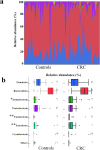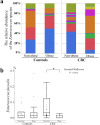Characteristics of the gut microbiome profile in obese patients with colorectal cancer
- PMID: 33860101
- PMCID: PMC8035457
- DOI: 10.1002/jgh3.12529
Characteristics of the gut microbiome profile in obese patients with colorectal cancer
Abstract
Background and aim: Obesity affects the gut microbiome, which in turn increases the risk for colorectal cancer. Several studies have shown the mechanisms by which some bacteria may influence the development of colorectal cancer; however, gut microbiome characteristics in obese patients with colorectal cancer remain unclear. Therefore, this study evaluated their gut microbiome profile and its relationship with metabolic markers.
Methods: The study assessed fecal samples from 36 consecutive patients with colorectal cancer and 38 controls without colorectal cancer. To identify microbiotic variations between patients with colorectal cancer and controls, as well as between nonobese and obese individuals, 16S rRNA gene amplicon sequencing was performed.
Results: Principal coordinate analysis showed significant differences in the overall structure of the microbiome among the study groups. The α-diversity, assessed by the Chao1 index or Shannon index, was higher in patients with colorectal cancer versus controls. The relative abundance of the genera Enterococcus, Capnocytophaga, and Polaribacter was significantly altered in obese patients with colorectal cancer, whose serum low-density lipoprotein concentrations were positively correlated with the abundance of the genus Enterococcus; among the most abundant species was Enterococcus faecalis, observed at lower levels in obese versus nonobese patients.
Conclusions: This study demonstrated several compositional alterations of the gut microbiome in patients with colorectal cancer and showed that a reduced presence of E. faecalis may be associated with obesity-related colorectal cancer development. The gut microbiome may provide novel insights into the potential mechanisms in obesity-related colorectal carcinogenesis.
Keywords: Capnocytophaga; colorectal neoplasms; enterococcus; gastrointestinal microbiome; obesity.
© 2021 The Authors. JGH Open: An open access journal of gastroenterology and hepatology published by Journal of Gastroenterology and Hepatology Foundation and John Wiley & Sons Australia, Ltd.
Figures

 , Non‐obese control;
, Non‐obese control;  , obese control;
, obese control;  , non‐obese CRC;
, non‐obese CRC;  , obese CRC.
, obese CRC.

 , Firmicutes;
, Firmicutes;  , Bacteroidetes;
, Bacteroidetes;  , Actinobacteria;
, Actinobacteria;  , Proteobacteria;
, Proteobacteria;  , Fusobacteria;
, Fusobacteria;  , Tenericutes;
, Tenericutes;  , Cyanobacteria;
, Cyanobacteria;  , others.
, others.



 , E. faecalis;
, E. faecalis;  , E. saccharolyticus;
, E. saccharolyticus;  , E. sulfureus;
, E. sulfureus;  , E. lactis;
, E. lactis;  , E. casseliflavus;
, E. casseliflavus;  , E. hirae;
, E. hirae;  , E. gallinarum;
, E. gallinarum;  , E. avium;
, E. avium;  , E. hermanniensis;
, E. hermanniensis;  , E. columbae;
, E. columbae;  , E. cecorum;
, E. cecorum;  , E. haemoperoxidus;
, E. haemoperoxidus;  , unclassified.
, unclassified.Similar articles
-
[Association between obesity with the diversity and genus of gut microbiota in school-aged children].Zhonghua Liu Xing Bing Xue Za Zhi. 2022 Feb 10;43(2):260-268. doi: 10.3760/cma.j.cn112338-20210617-00478. Zhonghua Liu Xing Bing Xue Za Zhi. 2022. PMID: 35184494 Chinese.
-
Alteration of the gut microbiota associated with childhood obesity by 16S rRNA gene sequencing.PeerJ. 2020 Jan 14;8:e8317. doi: 10.7717/peerj.8317. eCollection 2020. PeerJ. 2020. PMID: 31976177 Free PMC article.
-
Differences in the gut microbiome by physical activity and BMI among colorectal cancer patients.Am J Cancer Res. 2022 Oct 15;12(10):4789-4801. eCollection 2022. Am J Cancer Res. 2022. PMID: 36381318 Free PMC article.
-
Gut Microbiome Composition in Obese and Non-Obese Persons: A Systematic Review and Meta-Analysis.Nutrients. 2021 Dec 21;14(1):12. doi: 10.3390/nu14010012. Nutrients. 2021. PMID: 35010887 Free PMC article.
-
Microbiome and colorectal carcinogenesis: Linked mechanisms and racial differences.World J Gastrointest Oncol. 2022 Feb 15;14(2):375-395. doi: 10.4251/wjgo.v14.i2.375. World J Gastrointest Oncol. 2022. PMID: 35317317 Free PMC article. Review.
Cited by
-
Cancer type classification using plasma cell-free RNAs derived from human and microbes.Elife. 2022 Jul 11;11:e75181. doi: 10.7554/eLife.75181. Elife. 2022. PMID: 35816095 Free PMC article.
-
Relationships between gut microbiota, red meat consumption and colorectal cancer.J Carcinog Mutagen. 2022;13(3):1000385. Epub 2022 May 12. J Carcinog Mutagen. 2022. PMID: 37206892 Free PMC article.
-
Bacterial and Parasitic Pathogens as Risk Factors for Cancers in the Gastrointestinal Tract: A Review of Current Epidemiological Knowledge.Front Microbiol. 2021 Dec 8;12:790256. doi: 10.3389/fmicb.2021.790256. eCollection 2021. Front Microbiol. 2021. PMID: 34956157 Free PMC article. Review.
-
Rising colorectal cancer burden attributable to high body mass index in China from 1990 to 2021: a comprehensive analysis using the global burden of disease study.Front Endocrinol (Lausanne). 2025 May 15;16:1509497. doi: 10.3389/fendo.2025.1509497. eCollection 2025. Front Endocrinol (Lausanne). 2025. PMID: 40444236 Free PMC article.
-
Analysis of differences in intestinal flora associated with different BMI status in colorectal cancer patients.J Transl Med. 2024 Feb 9;22(1):142. doi: 10.1186/s12967-024-04903-7. J Transl Med. 2024. PMID: 38331839 Free PMC article.
References
-
- Bray F, Ferlay J, Soerjomataram I, Siegel RL, Torre LA, Jemal A. Global cancer statistics 2018: GLOBOCAN estimates of incidence and mortality worldwide for 36 cancers in 185 countries. CA Cancer J. Clin. 2018; 68: 394–424. - PubMed
-
- Ferlay J, Colombet M, Soerjomataram I et al. Estimating the global cancer incidence and mortality in 2018: GLOBOCAN sources and methods. Int. J. Cancer. 2019; 144: 1941–53. - PubMed
-
- Sung H, Siegel RL, Torre LA et al. Global patterns in excess body weight and the associated cancer burden. CA Cancer J. Clin. 2019;69: 88–112. - PubMed
-
- Bardou M, Barkun AN, Martel M. Obesity and colorectal cancer. Gut. 2013; 62: 933–47. - PubMed
-
- Sato T, Takeda H, Sasaki Y, Kawata S. Increased homeostasis model assessment‐insulin resistance is a risk factor for colorectal adenoma in Japanese males. Tohoku J. Exp. Med. 2011; 223: 297–303. - PubMed
LinkOut - more resources
Full Text Sources
Other Literature Sources

